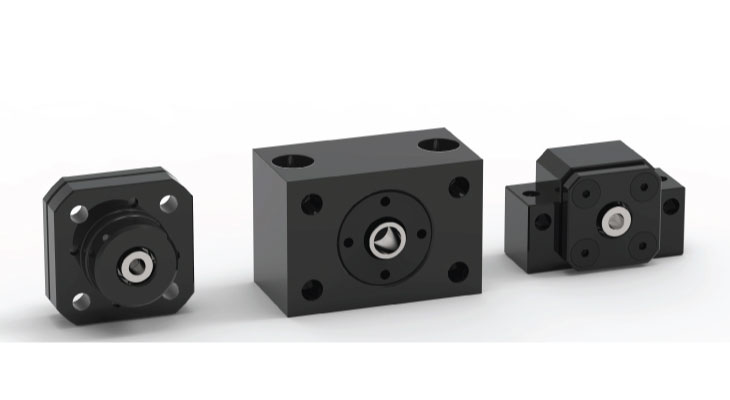Bearing Supports Made EZZE

Bearing end supports for ball screws and lead screws are essential to the life and accuracy of our system. They ensure load carrying capabilities and long life. They should be sized adequately to handle the axial loads required while supporting the shaft radially.
Several Helix Linear Technologies linear actuators like our 200 Series and 300 Series slides are constructed with EZZE™ mounts bearing end supports (aka pillow blocks) for the lead screw or ball screw shafts. These designs have established the bearing types, tolerances, fits, and clearances for a properly secured assembly. EZZE™ mounts have angular contact or deep groove radial bearings for accommodating axial and radial loads. Bearings are sized for both static load and dynamic load conditions.
A static load is based on whether the shaft passing through the bearing ID is stationary or not rotating. Generally, the dynamic load ratings for radial bearings are higher than the static load rating. This is due to the tendency to deform the balls permanently when applying high loads while the balls are not rolling. Permanent deformation of the balls is commonly referred to as brinelling (the permanent indentation of a hard surface).
Consider whether the forces acting on the linear actuator will put the lead screw or ball screw in compression or tension. If in compression, check to ensure that the unsupported length, end fixity, and length to diameter ratio L/D do not exceed the shaft's column strength. Column bending or buckling of the lead screw or ball screw can occur. If held in tension, the end configurations, such as lock nuts or mounting threads, could be the weak component. If the limits are exceeded, other alternatives should be considered.
The highest combination of load and speed that material will operate under is commonly referred to as PV (Pressure Velocity). PV is generally expressed in imperial units as pounds per square inch and feet per minute (psi-fpm). PV comes into play mainly with plastic lead screw nuts. Exceeding the limit means that the nut material will overheat, break down, and fail. Many high PV materials are available through Helix Linear for applications requiring higher loads and speeds. If the combination loads and speeds are too high for a plastic nut, a metal nut can be used, such as manganese bronze. A ball screw assembly is always a good choice for high load and speed applications.
Even at lower loads, speed presents its challenges. For example, the RPM limit of a rotating shaft is its critical speed. The theoretical formula to calculate critical speed is:
Suppose the lead crew or ball screw does not meet the application criteria. In that case, one should consider increasing the lead (advancement per revolution) so that the rotational speed is slower than a given linear speed. Changing end fixity, reducing the unsupported length, and increasing screw diameter are other ways to avoid exceeding critical speed, which can lead to wobble and vibration. Because the straightness of the shaft, run out of the bearing journals, and alignment can contribute to the problem, it is generally recommended to stay at an rpm that is 80% of critical speed to provide a safety factor.
Overall, when it comes to choosing the right linear actuator for your application you have to consider a lot of different aspects including backlash, safety factors, and cost. With all of that to consider, finding the right bearing end support should be easy. As mentioned above, EZZE bearing mounts from Helix Linear Technologies are already built in several of the linear actuators so you can focus on finding the right actuator for your linear motion needs. Contact a Helix application engineer now for more information on bearing end supports.


